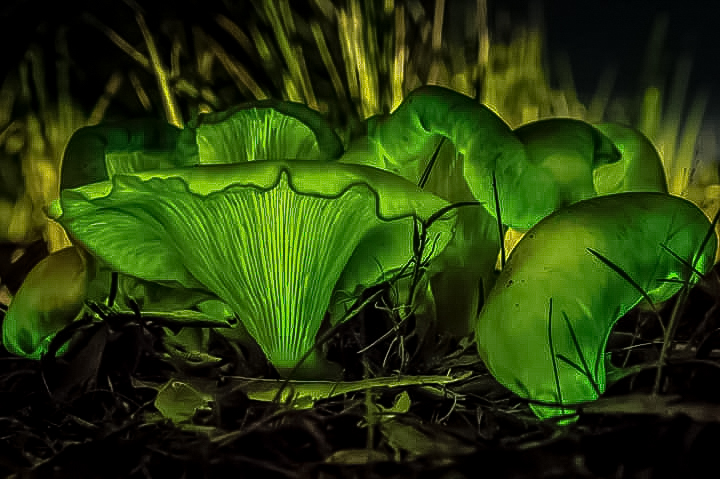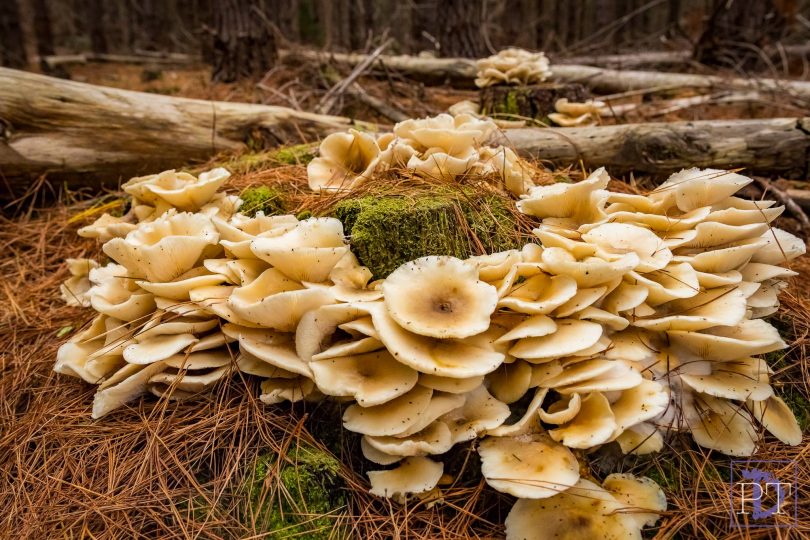
Tracey Harris has a specific goal for her daily walk these days – to find ghost mushrooms and note their location so that she and husband Peter can photograph them at night. Photo: Peter Harris.
If you’ve been for a walk in the forest lately, chances are you’ve walked straight past a colony of ghost mushrooms – a creamy white, orange or purple oyster-shaped fungi which often grow at the base of trees.
But at night, you can’t miss the rare bioluminescent fungus [Omphalotus nidiformis] or ‘Ghost Mushroom,’ as it glows with white light, radiating from its gills, which appears green in photographs.
Local photographers are going to great lengths to capture the eerie green glow while the fungi are visible above ground.
“We love to explore our local nature reserve looking for unusual fungi and since we’ve discovered the ghost mushrooms, my wife, Tracey, looks for them during the day and then we go back at night,” says Peter Harris, of Merimbula, who enjoys the challenge of photographing in tricky light.
Peter’s night time ghost mushrooms photos were taken with a 30-second exposure.

A cluster of ghost mushrooms in daylight. Photo: Facebook.
The best places to look for ghost mushrooms are areas with plenty of rotting wood, especially Casuarinas, Peter advises.
Casuarinas are not unlike the imported pine trees grown on plantations so it’s no surprise that Omphalotus nidiformis, although a native fungus, has its most famous habitat in a pine plantation near Mount Gambier in South Australia, known in the autumn as Ghost Mushroom Lane.
Peter and Tracey recently found the fungi at Araganu Beach and around Tathra but they most often frequent the Flora and Fauna reserve between Mirador and Tura Beach when looking for fungi.
Symony Douglas is a discovery ranger with Merimbula National Parks and is passionate about educating people about the world of fungus.
“This time of year is the best for spotting fungus because it’s what we call ‘fruiting’ or ‘flowering’ which are the parts of fungus that we see above ground. But of course, the fungus is always there!”

Scientists still don’t understand why some fungi glow. Theories that it was to attract insects to spread its spores have been disproven. Photo: Peter Harris.
Ms Douglas says that although it’s usually autumn rain that brings about a burst of fungus, this year, although there has been little rain in recent weeks, the “phenomenally moist and humid summer we’ve had has meant there is enough moisture around for a good crop of mushrooms.”
Laughing, Ms Douglas says she no longer puts limitations on where people might find interesting fungus –
“Because, often, it’s behind their house! I took my kids for a walk the other day and we found fungus growing in the sand at North Tura Beach. In the right conditions, fungus can flower anywhere. But don’t underestimate how quickly fungus appears after a downpour – you can find it when it’s still raining, it works so quickly!”
If you are interested in learning more about local fungus or taking part in a guided nature walk, please contact Merimbula National Parks and Wildlife Office.
Ms Douglas recommends an app, Fun-Key, developed by The University of Melbourne, to help novice fungi-hunters identify their finds.
Please don’t eat ghost mushrooms, which are poisonous, and always consult an expert before eating any wild fungus.







